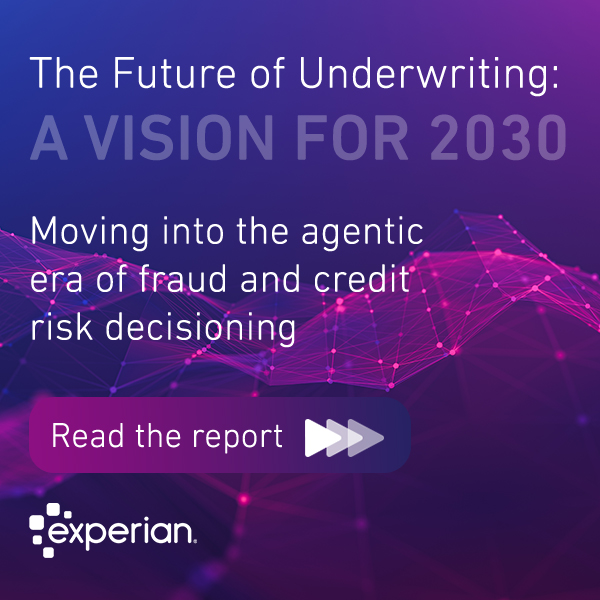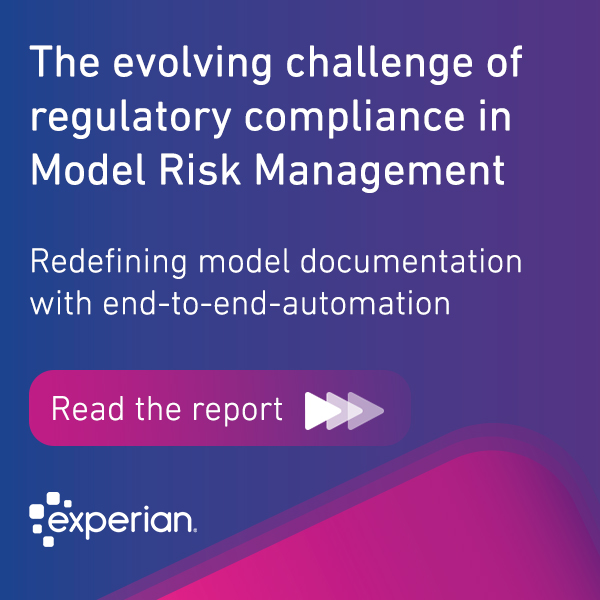Monthly Archives: July 2020

We've compiled the top global July headlines you need to stay in-the-know on the latest hot topics and insights from our experts. 1. Accelerating forward: How Covid-19 has changed banking foreverChris Fletcher, SVP Decision Management & Cloud Services, covers how Covid-19 forced banks to deliver a convenient, engaging, relevant and secure digital experience, and how this fundamentally changes how banks operate and deliver value to customers. 2. Q&A: Importance of fraud trends as businesses open upDigital Journal recently spoke with EK Koh, SVP of Global Identity & Fraud Solutions, on what businesses need to do to be prepared for issues around cybersecurity and fraud as they open back up the economy. 3. Businesses need to modernize their approach for delivering digital experiencesBirger Thornburn, CTO of Decision Analytics, shares how the rapidly changing environment has greatly accelerated the shift from offline to digital interactions. 4. Experian’s 2 latest moves to combat fraudAuto Fin Journal addresses Experian ramping up efforts to curtail synthetic identity fraud, a significant challenge for lenders and finance companies, and strengthen solutions to help businesses more quickly respond to rising fraud threats due to the Covid-19 global health crisis. 5. AI at Experian with Shri SanthanamShri Santhanam, our Head of Global AI & Analytics at DA, participated in the Artificially Intelligent podcast discussing ways to approach AI in a holistic way, always with a view to realizing the desired business outcomes and strategic impact. In this dynamic environment, stay up-to-date with our latest Research:

Due to Covid-19 , the focus on analytics and artificial intelligence (AI) has significantly increased. However, while companies have made significant investments in AI, many are struggling to show a tangible impact in return. One executive commented, “We have data science teams and a data lab where advance techniques like neural networks, GANs, etc. are successfully being used. However, less than 10% of our actual operational decisions and products are powered by AI and machine learning (ML). I would like us to be driving greater measurable impact and Covid-19 is exposing some of our execution gaps.” And, he’s not alone. Despite the investment, the true impact is elusive, and many businesses are not getting the desired effect from their efforts. Achieving the results needed to justify continuous investment will take a holistic approach. So, what can companies do to achieve this impact? The four pillars of holistic AI: performance, scaling, adoption and trust Achieving impact from AI requires taking a more holistic approach across four pillars — beyond just the delight of the data scientist producing a better performing model. 1. AI performance — outperforming the status quo and quantifying the impact This pillar is where most data scientists and companies tend to focus first, for example using modern AI techniques to create an underwriting model that performs better than traditional models. The so-called ‘data science moment of truth,’ where the data scientist declares that he has built a model which outperforms the status quo by 10%. However, it’s important to note model performance alone is not sufficient. We should look beyond the model to understand business performance. What quantifiable business impact does the 10% improvement deliver? How many more credit approvals? How much lower will the charge-off rate be? This reasoning provides the important business context around what the incremental performance means. 2. AI scaling — having the right technical infrastructure to operate models at scale This area is often ignored. The risk with data science teams is they can see their job as being completed with creating a better performing model. However, that’s just the beginning. The next important step is to operationally deploy the model and setup the operational infrastructure around it to make decisions at scale. If it is an underwriting model, is it deployed in the right decisioning systems? Does it have the right business rules around it? Will it be sufficiently responsive for real-time decision making, or will users have to wait? Will there be alerts and monitoring to ensure that the model doesn’t degrade? Are there clearly defined, transparent and explainable business strategies, and technology infrastructure and governance to ensure all stakeholders are aware? Is the regulatory governance around this model in place? Does the complexity in the model allow it to scale? Too often we see data scientists and data labs create great models that can’t scale and are impractical in an operating environment. One banking executive shared how her team had developed 5 machine learning models with better performance, but were in ‘cold storage’ verse in use, because they didn’t have the ability to scale and operationally deploy them effectively. 3. AI adoption — ensuring you have the right decisioning framework to help translate business decisions to business impact With better performing predictive models and the right technology, we now need to present the information in a way that is ‘human-consumable’ and ‘human-friendly.’ At one bank, we found they built a customer churn ML model for their front lines, but no one was using it. Why? They didn’t have the contextual information needed to talk to the customer — and the sales force didn’t have faith in it — so didn’t adopt it. Subsequently, they built a model with a simpler methodology and more information available at their fingertips — where decisions could be made. This was immediately adopted. This pillar is where the importance of decisioning tools is highlighted. The workflow and contextual information to allow a decision to be orchestrated and made is critical in driving AI adoption. 4. AI trust – having governance, guardrails and the appropriate explainability mechanisms in place to ensure models are compliant, fair and unbiased This final pillar is probably the most important for the future of AI — getting humans to trust it. In recent times we have seen numerous examples like the Apple Card, where the underlying principles and models have been called into question. For scalable AI impact, we need an entire ecosystem of people who can trust AI. To achieve this effect, you need to consistently apply the right principles over time. You also need the right decisions to be explained — like adverse action calls. Explainability capabilities help manage communication and understanding of advanced analytics, contributing to established AI trust. And, when fairness and bias issues come up, you need to provide good answers as to why decisions were made. AI is poised to fundamentally change the way we do business, and studies show that $3 to 5 trillion in global value annually, up to $15 trillion by 2030, is likely to be created. We believe the four pillars highlighted above will be key to accelerating the journey to driving positive results and capturing this value. At Experian, we are making investments to drive impact for our clients by delivering against these four pillars. Related articles: What is the right approach to AI and analytics for your business? Four fundamental considerationsHow rapidly changing environments are accelerating the Need for AI What’s new in online payment fraud Part 2: How AI and evolving regulation are driving change

Chris Ryan, Senior Fraud Business Consultant, talks to Nick Zulovich at the Auto Remarketing podcast about the new ways we are seeing fraud surface as the global pandemic evolves. "The pattern of activity that we're seeing that has really attracted my interest is this notion of human farming. A human farm is a pool of paid labor who research information on potential fraud victims using data that's been stolen through data breaches and using information that people publish through social media and other outlets. The objective of a human farmer is to be able to assemble a detailed profile of a potential fraud victim so that the perpetrator can better impersonate them and navigate around potential security measures and other obstacles that would normally be in the way." Chris Ryan, Senior Fraud Business Consultant Why the opportunity for human farming? People are out of work so there's a recruitment opportunity for those in need of an income. There is a flood of people into the online space who might not ordinarily engage digitally. This demographic may not be tech-savvy and maybe more susceptible to fraud methods such as phishing. Resources that typically screen for fraud are suffering due to office closures. The combination of high tech fraud to find potential victims plus skilled human intelligence makes these methods highly effective. New trend amidst new circumstances - the rise of synthetic ID Remote transactions combined with the high-value nature of the auto industry makes it a very attractive prospect to fraudsters. Even though purchases are down, the fraudsters are still active. Synthetic identity fraud, in particular, continues to be attractive because the identities are not real and therefore not suffering from the same downturn as genuine profiles. Listen to the full podcast here. Related articles: Getting to grips with the shifting fraud landscape Infographic: Top Global Fraud Trends 2020 Covid-19 as a Gateway to Fraud: Top 5 Global Fraud Trends to Watch Out for in 2020

Insights from Harry Singh, SVP, Global Decisioning, and Hristo Zahariev, Global Product Manager. Due to the global pandemic, one of the key challenges facing many consumers today is the ability to obtain support either from their credit provider or from government. This is manifesting itself in two ways – consumers facing very short-term financial difficulty, which might mean a payment holiday for a few months, or longer-term structural issues such as unemployment, which requires a very different set of treatments and outcomes. But what can businesses do to ensure consumer demand is met while taking care of customer experience? We look at the importance of digital channels within the decisioning environment, and how investment using AI can not only lead to consumer satisfaction now but also a sound business strategy for the future, regardless of how unpredictable that future may be. How the industry can respond to consumers during this time of need A recent study from March this year looked at businesses that are not yet fully digital in terms of how they handle their consumer interactions, and how they can reach out to consumers to help them during the Covid-19 crisis. With call centers and operational centers closed, and anything between five and 50,000 applications a week coming into banks across the world since the pandemic began, businesses have inevitably been struggling with demand. Based on existing operational models examined within the study, if businesses were to manually manage these applications, they would need to double in size in terms of full-time employees, and follow-up interactions post approval may still not be met. Managing demand and staying compliant, while enabling consumers to successfully interreact without waiting hours to get through is the challenge faced by many businesses. It’s a balancing act that is both an opportunity and a risk and should be treated as such. Helping consumers in a way that is digital, while allowing for self-serve, is fundamental in meeting these new levels of demand - and doing so in a way that doesn’t feel demeaning to the consumer is where true differentiation begins. During a stressful time for consumers, it’s important that businesses step up to the challenge of demystifying their interactions, removing embarrassment around finances while also retaining an element of human engagement. Thanks to AI and a layered, cloud-first approach to decisioning, contacting pre-qualified consumers for both forbearance and hardship can now be done through a business’s banking application or their website, using artificially intelligent virtual assistants that can be deployed in a multitude of different digital channels. The consumer perspective: we need more than a chatbot Chatbots are very effective and useful in many ways, but when an interaction gets complex or there's something of a regulated or more subjective nature, it becomes difficult for that chatbot to provide the kind of service consumers are looking for. The answer lies in continuous learning, which moves away from the decision tree structure of a traditional chatbot and into the realms of natural language processing. The new age of virtual assistant remembers interactions and then learns from them, has short-term and long-term conversation goals, and recognizes small talk. The result feels a lot more empathetic and allows for always-on and real-time consumer interaction. How businesses can develop their strategies not only for today, but going forward Bringing together digital capabilities, analytical insights, and data to understand the affordability of a consumer is critical. Using demographic and geographic data, businesses need those insights, regardless of whether we are in a growth environment, a benign environment, or as we're seeing right now, a recession of macro-economic downturn. Businesses choosing to invest now to address their operational and strategic challenges are not just responding to Covid-19, they are looking beyond and into strategic requirements of the future. Financial difficulty may be more acute right now, but it has always existed and always will, for various reasons.

In the second part of the Juniper Research and Experian podcast series on online payment fraud, we talk to Nick Maynard from Juniper Research, and David Britton, Vice President of Industry Solutions at Experian, about maturity in artificial intelligence and virtual assistants, and their current ability to respond to current business challenges. "What we're seeing in the consumer space is that AI is powering these virtual assistants and typically Alexa, Siri, Google, are the three big examples. What that's doing is creating an additional channel, it's a new way for users to interact... it mirrors the digital transition and the mobile transition over a number of years."Nick Maynard, Juniper Research "If you consider where artificial intelligence and machine learning are coming together, this is not going to be a big bang launch into market. We're seeing a slow, incremental roll-out." "In the physical world, when we talk about risk and recognition of a consumer, the human to human interaction takes in a tremendous number of variables to ensure that the person you're engaging with is who they claim to be.... in the digital space, that was eliminated overnight, and cosnumers were using a device as a proxy to represent them to another system or set of devices, like bank servers and eCommerce web servers." David Britton, VP of Industry Solutions We also discuss key points around evolving regulatory frameworks, and how they are driving change in identity-based solutions. Listen to the full podcast episode here, and don't forget to listen to What’s new in online payment fraud Part 1: Implications for consumers and businesses if you haven't already.




